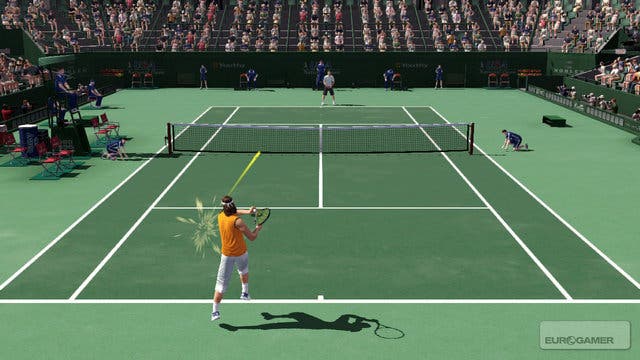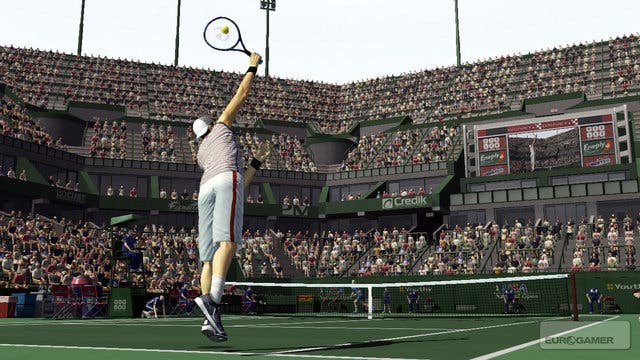Smash Court Tennis 3
Courting disaster.
The bedrock of any successful tennis game is fluid, intuitive control. It's the old 'easy to learn, hard to master' mantra, where the refined subtlety of the control system gives the player confidence to swat the ball around the court with precision almost through instinct. Smash Court Tennis 3 instantly fails in this regard, and no amount of practice allows you to get over this basic hurdle. You're constantly left fighting against poor controls, lame player AI and sluggish response.
It's always ominous when faced with a dedicated tutorial in a game as intuitive as tennis, but to get anywhere with Namco-Bandai's latest effort you're more or less forced to slog your way through 22 lessons. Having endured similar japes in Top Spin 3, there was at least the hope that Smash Court Tennis 3 would also offer payback in the form of eventual enjoyment. But no. Instead, the more likely scenario is mild bafflement as you end up replaying lessons to suss out the nuances - such as the wafer-thin difference between a 'nice' shot and a power shot. You might also wonder why directing precise serves is such a tall order, or why the shot mechanic never builds in any headroom to allow the player to instinctively reach for shots.
It all starts off quite promisingly, though. The way the game illustrates the serve mechanic is sensible, with a rapidly contracting circle above the player's arm providing the visual cue for the sweet spot. Unfortunately, directing the ball where you want it to go is inexact, so the chances of smacking it into the far corners are practically zero and you're forced to play it far safer than you want. In other words, you lose out on one of the tennis player's key weapons.
General on-court play is every bit as dissatisfying, despite the promise of being able to strike back at your opponent with a full range of shots. All the obvious options are available to you, including top-spin, slices, lobs, drop-shots and smashes, with a dash option available on the right trigger should you find yourself needing to make up ground. But with the pace and direction of your return often dictated by arbitrary timing, rallies can drag on for ages even against low-ranked opponents. What's more, you'll frequently lose out on a point simply because the game deemed your player to be too far from the ball. You're already mentally preparing the shot and direction, but find yourself yanking the player away from the flight of the ball instead. Such rudimentary control issues immediately rob you of any desire to get through the pain barrier.

Of course it's essential to get stuck into the career mode to really get into tennis games, but, er, not with Smash Court Tennis 3. The game has an "auto match" facility, which essentially allows you to climb the ranking system and level up your player RPG-style without ever having to play tennis. But although this soulless non-playing experience might provide a shortcut to giving you a half-decent user-created player (and some accidental Achievement points), it's about as rewarding as playing Kevin Thom's original 1983 ZX Spectrum Football Manager 25 years on.
Between tournaments you might imagine there's light relief from the training exercises, but some of these are every bit as soul-crushing as the main game. Several of the exercises actually insist on ridiculous degrees of serving precision, which you may remember is practically impossible, and so you gain almost no experience points for your pain. Less stressful training exercises are available, such as the footwork trial where you attempt to run across a series of tiles while returning shots, or others where you must return shots between obstacles, or with a specific shot. But there's no charm to any of them. The customisation element of the game is similarly vacuous and half-baked. Not since the early part of the decade have create-a-player options been this limited, and nor have the ranges of accessories and equipment.

Given all of the above, it probably won't come as a shock to discover that the game's not exactly a technical tour-de-force either. In fact, there's an ugly suspicion the developer has done little more than directly port the entire game from the underwhelming PSP version released earlier this year. The Xbox 360 release's pitifully bland visuals certainly back that up, with unconvincing animation compounding uninspiring, low-detail character models. Even the courts are crap.
And so all that remains is a bland Arcade mode of varying difficulty or a simple Exhibition mode, and neither raises the pulse, despite the presence of some of the world's most famous tennis stars. If the game feels wrong, it doesn't really matter whether you dress it up in expansive career clothes or play a one-off game. Local or online multiplayer offer a diversion, but - oh look, a herd of elephants! - Virtua Tennis 3 and Top Spin 3 are better alternatives. For this and everything else, frankly. Even the relatively limited SEGA Superstars Tennis is far, far more playable. Ultimately this is soulless and boring with almost no redeeming features, and the worst tennis game of this generation by some margin.

